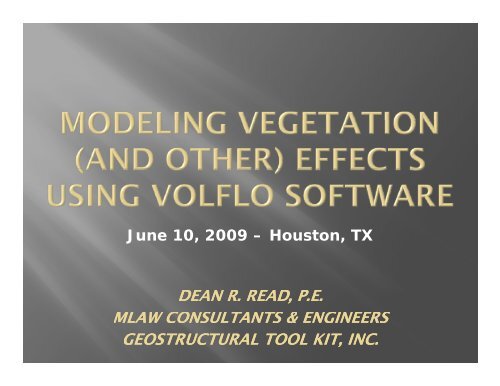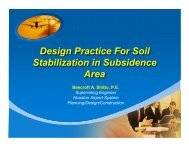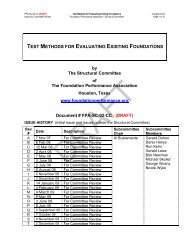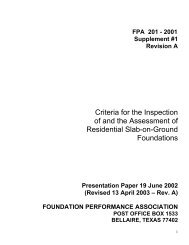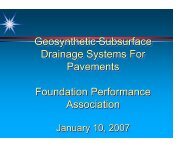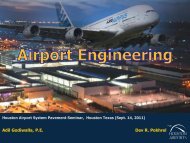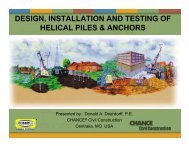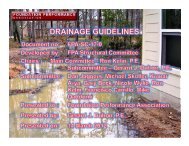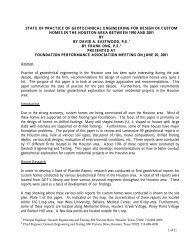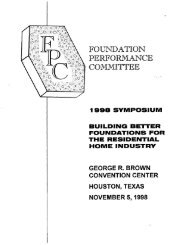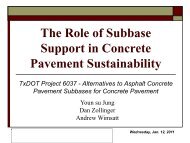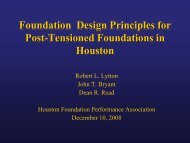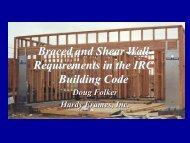Modeling Vegetation (and other) Effects using VOLFLO Software
Modeling Vegetation (and other) Effects using VOLFLO Software
Modeling Vegetation (and other) Effects using VOLFLO Software
You also want an ePaper? Increase the reach of your titles
YUMPU automatically turns print PDFs into web optimized ePapers that Google loves.
June 10, 2009 – Houston, TX
H<br />
<br />
OR Z<br />
SWELL <br />
H <br />
i<br />
SHRINK<br />
<br />
H<br />
=Vertical volume change per element<br />
H<br />
Z =Element thickness<br />
V<br />
H<br />
H<br />
<br />
f<br />
V<br />
<br />
<br />
V<br />
V<br />
=Percent volume change per element<br />
f<br />
<br />
<br />
<br />
=vertical volume change coefficient<br />
(f = 0.5 shrink, f = 0.8 swell)<br />
3
Percent Volume Change Per Element<br />
SWELL<br />
V hf<br />
<br />
<br />
f <br />
f <br />
( )(log )<br />
( )(log )<br />
( )(log <br />
10 10<br />
10 <br />
) <br />
V<br />
hf<br />
<br />
<br />
f <br />
f <br />
<br />
<br />
<br />
<br />
<br />
<br />
<br />
<br />
<br />
<br />
<br />
h<br />
<br />
o<br />
V<br />
hi<br />
<br />
i <br />
i <br />
V<br />
V<br />
<br />
SHRINK<br />
<br />
<br />
<br />
)(log10<br />
) ( )(log10<br />
) ( )(log<br />
<br />
) <br />
hf<br />
<br />
<br />
f <br />
f <br />
<br />
<br />
<br />
<br />
<br />
<br />
<br />
<br />
o<br />
hi<br />
<br />
i <br />
i <br />
( <br />
h<br />
<br />
10<br />
Note: sign change<br />
4
)<br />
)(log<br />
(<br />
)<br />
)(log<br />
(<br />
)<br />
)(log<br />
( 10<br />
10<br />
10 <br />
<br />
<br />
<br />
<br />
<br />
<br />
<br />
<br />
<br />
<br />
<br />
<br />
<br />
<br />
<br />
<br />
<br />
<br />
<br />
<br />
<br />
<br />
<br />
<br />
<br />
<br />
<br />
i<br />
f<br />
o<br />
i<br />
f<br />
i<br />
f<br />
h<br />
h<br />
h<br />
V<br />
V<br />
<br />
<br />
<br />
<br />
<br />
<br />
<br />
Matrix<br />
Suction<br />
component<br />
Overburden<br />
component<br />
Osmotic<br />
Suction<br />
component<br />
5<br />
component<br />
component
Suction Compression<br />
Index corrected for fine<br />
Matrix Suction component<br />
clay <strong>and</strong> coarse grained SUCTION<br />
components<br />
( )(log )<br />
10 <br />
V h<br />
( <br />
)(log <br />
f<br />
).....<br />
h 10 <br />
<br />
h<br />
V<br />
<br />
hi<br />
<br />
6
h <br />
(log10 <br />
) <br />
hf<br />
<br />
<br />
<br />
hi<br />
<br />
really is a CHANGE<br />
Final<br />
suction<br />
Initial<br />
Suction<br />
h <br />
(l (log <br />
f<br />
) llog<br />
( h ) llog<br />
( h<br />
10 f 10<br />
h <br />
i<br />
<br />
<br />
<br />
<br />
<br />
<br />
10 i<br />
)<br />
7
A suction change from dry (higher suction) to wet (lower suction)<br />
results in swell (ym edge).<br />
WET<br />
Final<br />
Suction<br />
Profile<br />
DRY<br />
Initial<br />
SSuction ti<br />
Profile<br />
8
A suction change from wet (lower suction) to dry (higher suction)<br />
results in shrink (ym center).<br />
WET<br />
Initial<br />
Suction<br />
Profile<br />
DRY<br />
Final<br />
Suction<br />
Profile<br />
9
Consolidation Theory<br />
Shrink / Swell Theory<br />
Consolidation Index<br />
Cs<br />
Effective Pressure<br />
Change - p<br />
Suction Compression<br />
Index - h<br />
Suction Change - pF
PTI didn’t develop unsaturated soil<br />
mechanics h i (USM) (USM).<br />
PTI adopted USM to define their soil /<br />
structure interaction model. As a<br />
result result, the modeling of simple <strong>and</strong><br />
complex cases are possible.<br />
(Is this possible for <strong>other</strong> design procedures?)<br />
PTI made simplifying assumptions,<br />
provided boundary conditions for use<br />
in design des g <strong>and</strong> a d techniques tec ques to dete determine e<br />
certain variables.<br />
13
PTI adopted adopted the principles of unsaturated<br />
soil mechanics to model the complex<br />
interaction between the slab-on-ground<br />
foundation <strong>and</strong> the supporting expansive<br />
soil.<br />
The soil / structure interaction models<br />
are defined by e m <strong>and</strong> y m values.<br />
14
Center Lift designation may be misleading.<br />
Edge Drop may be more appropriate.<br />
15
PTI PTI’s s Differential Soil Movement<br />
17
ym represents the change in the<br />
soil surface elevation at two<br />
locations.<br />
18
y m is (<strong>and</strong> always has been)<br />
developed <strong>using</strong> the principles of<br />
unsaturated soil mechanics.<br />
Boundary conditions, assumptions<br />
<strong>and</strong> methods have been revised<br />
over time to reflect changes in the<br />
state of the art <strong>and</strong> account for<br />
performance issues.<br />
19
y m is NOT the expected differential<br />
deflection of the foundation. y m should<br />
always be greater than the actual<br />
differential deflection of the foundation<br />
due to foundation stiffness.<br />
y ym would only equal the differential<br />
deflection for a “perfectly flexible”<br />
foundation with no externally applied<br />
loads.<br />
y m is not PVR<br />
20
ym, in very simple l terms, is a<br />
function of a change in suction<br />
AND how much the soil changes<br />
volume for a given suction<br />
change.<br />
21
The change in suction used for design is typically<br />
represented by a suction envelope since actual<br />
suction values are not known at the time of<br />
construction of the foundation or over the life of<br />
the structure structure. (suction does not need to be<br />
measured for typical design for this reason)<br />
The design suction envelope approach will be<br />
conservative.<br />
Assuming you know exactly what the suction<br />
values are at the time of construction would be<br />
dangerous.<br />
22
Initial<br />
Suction<br />
Profile<br />
Measured Suction<br />
(Spring)<br />
Final<br />
Suction<br />
Profile<br />
Measured Suction<br />
(Summer)<br />
A Suction Envelope consists of<br />
an Initial Suction Profile<br />
(assumed suction at the time of<br />
foundation construction) <strong>and</strong> a<br />
Final Suction Profile<br />
(assumed maximum or<br />
minimum suction to be expected<br />
over the life of the foundation).<br />
The suction profiles do not<br />
represent the actual field suction<br />
but the boundary conditions<br />
which the suction is not<br />
expected p to ggo beyond. y<br />
23
Suction Profiles used to construct the envelopes can model :<br />
Sites controlled by climate (precipitation, evaporation, etc.) –<br />
commonly assumed to be “trumpet” shape based on Mitchell’s<br />
permeability (typical FINAL PROFILE for Houston area)<br />
Equilibrium condition (typical INITIAL PROFILE for<br />
Houston area)<br />
Site modifications such as:<br />
Moisture controlled fill pads p<br />
Moisture injection<br />
Vertical moisture barriers<br />
<strong>Vegetation</strong><br />
Trees (remove before or planted after foundation construction)<br />
Fl Flower BBeds d<br />
Poor Drainage<br />
24
Post-Equilibrium Suction Envelope - Starts<br />
with an initial equilibrium suction profile <strong>and</strong><br />
changes to either a final wet or dry climate<br />
controlled suction profile.<br />
Post-Construction Suction Envelope - Starts<br />
with either an initial wet or dry climate controlled<br />
suction profile <strong>and</strong> changes to the opposite climate<br />
controlled suction profile.<br />
27
Swell Case – Both envelopes start dry <strong>and</strong> end wet.<br />
Surface Suction<br />
Value<br />
Final Suction<br />
Profile for site<br />
controlled by<br />
climate<br />
Initial Suction<br />
Profile assumed<br />
to be equilibrium<br />
suction<br />
Depth to<br />
Constant Co sta t Suction Suct o<br />
Surface Suction<br />
Value<br />
Post–Equilibrium Post–Construction<br />
28
Shrink Case – Both envelopes start wet <strong>and</strong> end dry.<br />
Post–Equilibrium Post–Construction<br />
29
The magnitude of shrink <strong>and</strong> swell is a<br />
function of the area between the two profiles.<br />
Post-Equilibrium<br />
Post-Construction<br />
For the same soil, soil the Post-Construction Post Construction Envelope (on the right)<br />
will produce significantly more swell than the Post-Equilibrium<br />
Envelope on the left.<br />
30
When to use Post-Equilibrium Envelopes<br />
versus Post-Construction Envelopes? p<br />
(PTI Addendum #1)<br />
Thornthwaite o a e Moisture o s u e Index de (TMI) ( )<br />
-40 -30 -20 -10 0 +10 +20 +30 +40<br />
+15<br />
Post- Post-<br />
Post-<br />
Equilibrium Construction<br />
Equilibrium<br />
31
Thornthwaite Moisture Index (TMI)<br />
-40 -30 -20 -10 0 +10 +20 +30<br />
+15<br />
+40<br />
Houston, Texas (I m = +17)<br />
USE POST-EQUILIBRIUM<br />
MODEL<br />
32
The magnitude of shrink <strong>and</strong> swell is a function of the<br />
area (sum of the volume change for each element)<br />
between the two profiles.<br />
For the same soil the envelope on the right will produce<br />
significantly more shrink.<br />
Note the right envelope is for illustration purposes only <strong>and</strong> is NOT<br />
representative of an envelope that should be used for design purposes.<br />
33
What values of the surface suction should<br />
be used for “typical” design? g<br />
PTI RECOMMENDS A TOTAL<br />
DESIGN SURFACE SUCTION<br />
CHANGE OF 11.5 5<br />
4.5 pF Typical dry<br />
surface su ace suction suct o<br />
value<br />
3.0 pF Typical wet<br />
surface suction Changed to 3.0 pF from<br />
value<br />
2.5 pF in Addendum #1.<br />
34
1.1 pF + 0.4 pF = 1.5 pF (Total Suction Change at Surface)<br />
Shrinking Swelling<br />
35
Low Expansive Soil<br />
(PI = 19)<br />
Moderately Expansive Soil<br />
(PI = 28)<br />
Expansive Soil<br />
(PI = 56)<br />
y ym center t y ym edge d h<br />
0.6 inches 0.2 inches 0.03<br />
0.9 inches 0.4 inches 0.05<br />
1.6 inches 0.7 inches 0.09<br />
36
To model special non-climate controlled<br />
conditions you have to determine:<br />
1. Shape of suction profile for non-climate<br />
controlled co t o ed co conditions d t o s<br />
2. Which suction profile (initial or final) will<br />
b be affected ff t d<br />
38
4.5 pF is considered the<br />
wilting point of most<br />
vegetation. For the root<br />
zone, it is assumed that the<br />
t tree will ill dry d out t the th soil il to t<br />
a suction of 4.5 pF.<br />
The depth of soil affected by<br />
trees is commonly assumed to<br />
be 2 feet deeper than the<br />
deepest root root.<br />
Below the depth influenced by<br />
the tree, the suction profile will<br />
trend back to the equilibrium<br />
suction value.<br />
39
Since the tree is<br />
removed JUST BEFORE<br />
(
Since climate will<br />
control how wet the soil<br />
can get after<br />
construction the climate<br />
controlled wet suction<br />
profile should be used<br />
for the FINAL SUCTION<br />
PROFILE.<br />
41
After the tree has been<br />
removed the only<br />
mechanism to reduce<br />
the suction would be<br />
the climate. Therefore<br />
the climate controlled<br />
envelope would be<br />
appropriate for<br />
shrinking. g<br />
43
Shrinking Swelling<br />
44
The magnitude of swell is a function of the<br />
area between the two profiles.<br />
Swell due to climate only<br />
Swell due to tree being removed just<br />
before construction.<br />
For the same soil, the envelope due to the tree being removed<br />
will produce significantly more swell than the envelope being<br />
controlled just by the climate.<br />
45
Low Expansive Soil<br />
(PI = 19)<br />
Moderately Expansive Soil<br />
(PI = 28)<br />
Expansive Soil<br />
(PI = 56)<br />
y m center y m edge h<br />
0.6 inches 2.5 inches 0.03<br />
0.9 inches 4.2 inches 0.05<br />
1.6 inches 8.4 inches * 0.09<br />
* It is not reasonable to construct ANY<br />
type of slab-on-ground foundation on this<br />
expansive of soil if a tree is removed just<br />
before construction without treating the<br />
soil or allowing it to at least partially<br />
equilibrate with the surrounding soils.<br />
46
3 large trees reportedly<br />
removed within 2<br />
weeks of foundation<br />
construction.<br />
Total Elevation differential = 8.2 inches<br />
PI between<br />
50 <strong>and</strong> 60<br />
47
Trees typically are not removed just before the<br />
construction of foundations<br />
foundations.<br />
More commonly sites are cleared <strong>and</strong><br />
foundations are constructed 1 to 2 years later<br />
<strong>and</strong> therefore the previously presented model<br />
will be excessively conservative.<br />
48
Reduuction<br />
of Suction S Chaange<br />
100%<br />
90%<br />
80%<br />
70%<br />
60%<br />
50%<br />
40%<br />
30%<br />
20%<br />
10%<br />
0%<br />
y (X/5) 05<br />
y= (X/5) 0.5<br />
The time to rehydration<br />
(5 years in this<br />
example) may vary.<br />
0 1 2 3 4 5<br />
Time from Tree Removal (Years) 49
Surface<br />
Sucction<br />
due to<br />
removedd<br />
tree (pF)<br />
4.5<br />
4.0<br />
3.5<br />
3.0<br />
y (X/5) 05<br />
y= (X/5) 0.5<br />
0 1 2 3 4 5<br />
Time from Tree Removal (Years)<br />
50
Time = 0 Time = 1 Year<br />
51
Ti Time = 2 YYears<br />
Time = 5 Years<br />
Time = 4 Years<br />
52
Time between tree<br />
removal <strong>and</strong><br />
foundation<br />
construction<br />
Surface Suction<br />
due to tree Expansive Soil Moderately<br />
Expansive Soil<br />
0 4.5 pF 8.4 inches 4.2 inches<br />
1 Year 4.0 pF p<br />
3.9 inches 2.0 inches<br />
2 Years 3.8 pF 2.4 inches 1.3 inches<br />
3 Years 3.6 pF 1.4 inches 0.7 inches<br />
4 Years 3.5 pF 1.1 inches 0.5 inches<br />
5 Years 3.4 pF 0.7 inches 0.4 inches<br />
53
The suction profile to a heavily<br />
wooded site will be similar to<br />
an isolated tree<br />
EXCEPT<br />
the extent of the dry zone will<br />
be greater.<br />
The dry zone will encompass a<br />
greater portion of the<br />
foundation than an isolated<br />
tree.<br />
55
Due to climate influences alone after<br />
construction, the soil around the<br />
perimeter i t will ill respond d to t moisture i t<br />
changes very quickly but it will take a<br />
long time for moisture to reach the<br />
interior interior.<br />
Since ym is a change in the soil surface<br />
elevation at two locations the<br />
conservative assumption would be that<br />
the soil at the perimeter would experience<br />
its full change in moisture before the<br />
interior experiences any.<br />
Over time the suction in the interior may<br />
trend towards equilibrium.<br />
56
Since it is unlikely that<br />
the dry zone from a<br />
heavily y wooded site will<br />
encompass the entire<br />
foundation, there is still<br />
a potential for some soil<br />
shrinkage to occur.<br />
The foundation should<br />
also l be b designed d i d for f<br />
shrinkage resulting from<br />
climate only.<br />
57
Shrinking Swelling<br />
58
The same<br />
suction profile<br />
can be assumed<br />
to model the<br />
effect of a tree<br />
planted after<br />
construction<br />
EXCEPT …..<br />
60
…. it would be<br />
the final suction<br />
profile.<br />
61
For post post-equilibrium<br />
equilibrium<br />
areas (such as<br />
Houston) the<br />
INITIAL SUCTION<br />
PROFILE would be<br />
assumed to be the<br />
equilibrium q pprofile<br />
(at the time of<br />
construction).<br />
62
Note: This is used primarily for analysis of foundation performance<br />
after construction. It is not typically used as a design suction<br />
envelope. If it is to be used for design, the corresponding swelling<br />
suction envelope would be climate controlled.<br />
63
Low Expansive Soil<br />
(PI = 18)<br />
Moderately Expansive Soil<br />
(PI = 28)<br />
Expansive Soil<br />
(PI = 56)<br />
y ym center t h mean<br />
1.3 inches 0.03<br />
2.2 inches 0.05<br />
4.0 inches 0.09<br />
64
Excessive watering of a<br />
flowerbed could lower the<br />
suction below 3.0 pF.<br />
Depending on the amount<br />
of f watering t i the th suction ti<br />
could be as low as 2.5 pF.<br />
The excessive watering will<br />
decrease the suction for several<br />
feet. The depth of influence may<br />
vary but 3 to 4 feet is possible possible.<br />
Below the depth influenced by<br />
the excessive watering, g the<br />
suction profile will trend back<br />
to the equilibrium suction<br />
value.<br />
66
Since the excessive<br />
watering of the<br />
flo flower e bed doesn’t<br />
occur until after the<br />
foundation is built,<br />
the flower bed<br />
profile would be<br />
used as the FINAL<br />
SUCTION PROFILE.<br />
67
For post-equilibrium<br />
post equilibrium<br />
areas (such as<br />
Houston) the<br />
INITIAL SUCTION<br />
PROFILE would be<br />
assumed to be the<br />
equilibrium q pprofile<br />
(at the time of<br />
construction).<br />
68
Low Expansive Soil<br />
(PI = 19)<br />
Moderately Expansive Soil<br />
(PI = 28)<br />
Expansive Soil<br />
(PI = 58)<br />
y ymedge m edge<br />
Climate<br />
y ymedge m edge<br />
Flower Bed<br />
hmean<br />
0.2 inches 0.5 inches 0.03<br />
0.4 inches 0.9 inches 0.05<br />
0.7 inches 1.8 inches 0.09<br />
69
A vertical moisture barrier will limit<br />
the suction of the soil behind the<br />
barrier such that it does not increase<br />
or decrease beyond the equilibrium<br />
value. l e<br />
71
Assumed 3’ deep<br />
barrier. Barrier<br />
prevents t suction ti<br />
from increasing<br />
beyond equilibrium.<br />
Suction profile for<br />
climate controlled<br />
site<br />
Shrink is reduced by y<br />
eliminating this<br />
change in suction<br />
72
Suction profile for<br />
climate controlled<br />
site<br />
Swell is reduced by<br />
eliminating this<br />
change in suction<br />
Suction Profile for<br />
removed tree<br />
Assumed 3’ deep<br />
barrier. Barrier<br />
prevents any suction<br />
change behind<br />
barrier (potentially<br />
unconservative)<br />
73
Lo Low EExpansive pansi e Soil<br />
(PI = 19)<br />
Moderately Expansive Soil<br />
(PI = 28)<br />
Expansive Soil<br />
(PI = 58)<br />
y m edge<br />
ym edge g<br />
w/3ft<br />
barrier<br />
2.5 inches 1.33 inches<br />
4.2 inches 2.3 inches<br />
8.4 inches 4.4 inches<br />
74


